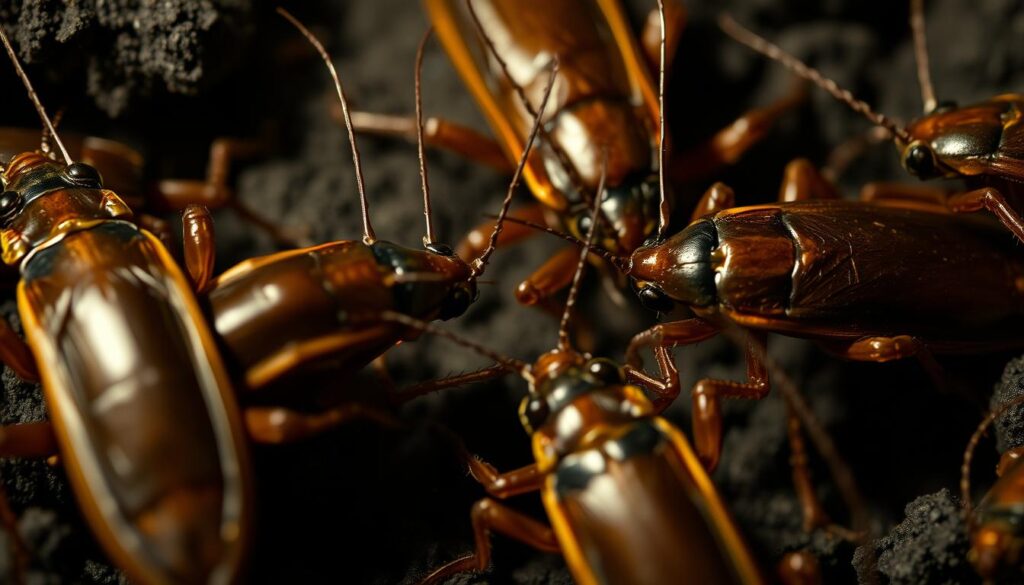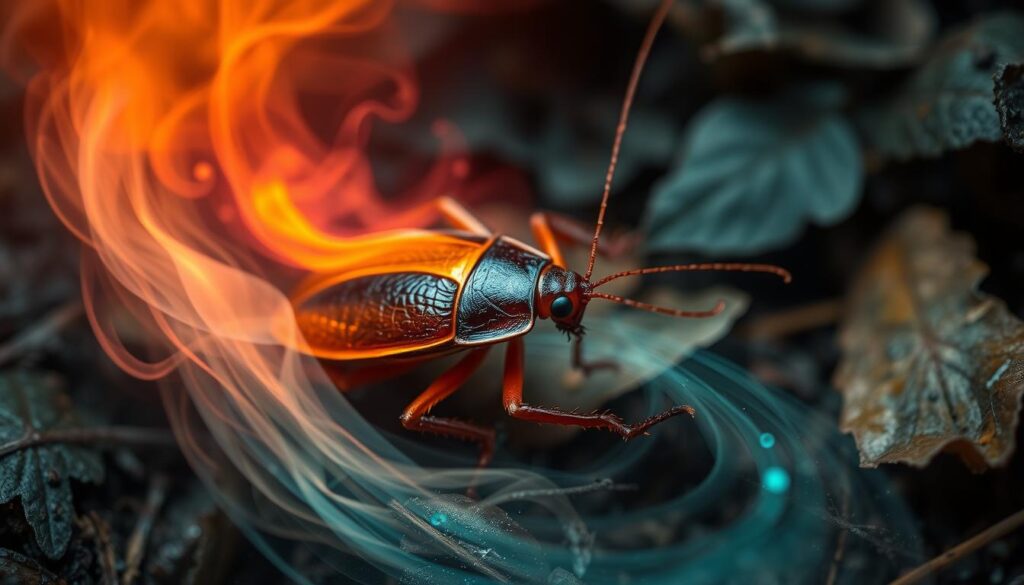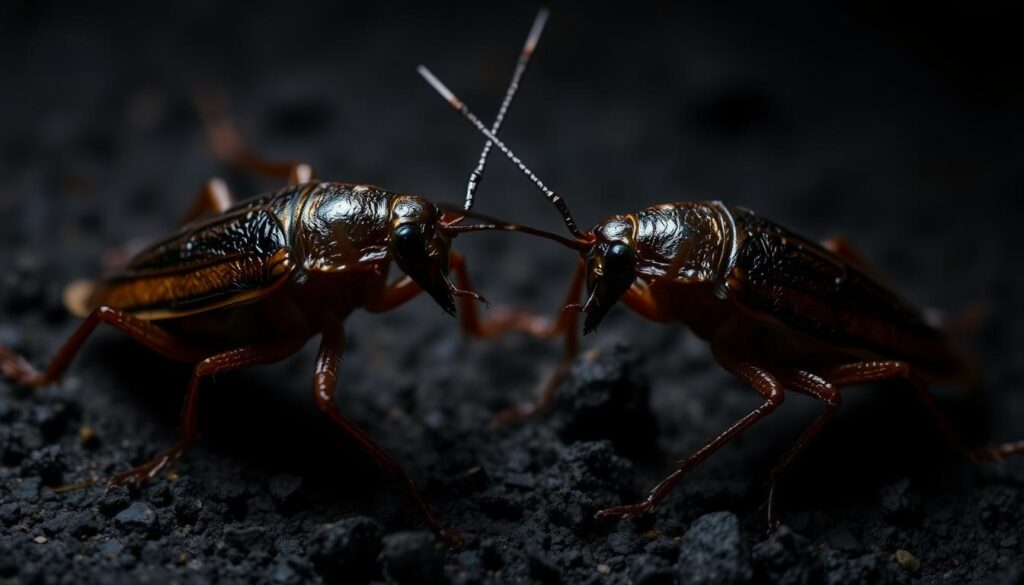How do cockroaches communicate with each other?
Cockroach communication is a topic that has caught a lot of interest lately. It’s key to understanding how to control pests and see cockroaches’ complex social lives. Their behaviour is intricate, and how they talk to each other is vital for survival.
Looking into how cockroaches communicate can teach us a lot about them. They use chemical signals and physical actions to talk to each other. By learning about these ways, we can better understand their behaviour and find ways to manage their numbers.

Key Takeaways
- Cockroach communication is essential for their survival and social dynamics
- Understanding how cockroaches communicate can help develop effective pest control methods
- Cockroach behaviour is complex and involves various forms of interaction
- Cockroaches use chemical signals and physical communication to interact with each other
- Studying cockroach communication can provide valuable insights into their behaviour and ecology
The Fascinating World of Cockroach Communication
Cockroaches have developed complex ways to talk to each other and their world. Learning about insect communication helps us understand their social lives. By studying cockroaches’ social behaviour, we can see how they live and work together in their colonies.
At the core of cockroach talk is a system of cockroach sensory organs. These organs help them sense and react to smells, sounds, and touch. This network lets cockroaches work together, find partners, and warn each other of dangers.
Why Understanding Cockroach Communication Matters
Studying how cockroaches talk to each other gives us important info. It helps us know more about their behaviour, social setup, and biology. This knowledge can lead to better control of their numbers and lower disease risks.
Basic Communication Methods Overview
Cockroaches communicate in many ways, like through smells, sounds, and touch. Smells, or pheromones, are key in their talks. These chemical signals share information about food, mates, and dangers.
The Evolution of Cockroach Communication
The way cockroaches talk has changed over time. It’s been shaped by their environment and the need to adapt. Now, they have complex ways to communicate, helping them survive in many different places.
Chemical Signals: The Primary Language of Cockroaches
Cockroaches use chemical signals to talk to each other. These signals, often cockroach pheromones, are key for sharing information about food, danger, and mates. They warn others of threats by releasing certain pheromones or leading them to food.
Some common types of cockroach pheromones include:
- Aggregation pheromones, which attract cockroaches to a specific location
- Mating pheromones, which help cockroaches find potential mates
- Alarm pheromones, which alert cockroaches to potential threats
Knowing how cockroach behaviour works and their use of chemical signals is key for fighting pests. We can control their numbers and stop infestations by messing with their cockroach pheromones.
Understanding Cockroach Pheromones and Their Functions
Cockroach pheromones are special chemical signals. They play a key role in how cockroaches behave and communicate. These signals can be divided into three main types: aggregation, mating, and alarm pheromones.
Aggregation pheromones help cockroaches come together in big groups. They often do this where there’s lots of food or shelter. Mating pheromones help males and females find each other for mating. Meanwhile, alarm pheromones warn cockroaches of danger, helping them stay safe from predators.
Types of Pheromones
- Aggregation pheromones: facilitate group formation and social behaviour
- Mating pheromones: enable mate selection and reproduction
- Alarm pheromones: trigger warning signals and defensive responses
Knowing about the different types of cockroach pheromones helps us find better ways to control them. This knowledge is key for creating new pest control methods. It shows how important it is to keep studying these chemicals.

Physical Communication Methods in Cockroaches
Cockroaches communicate in many ways, including through physical contact. They use body language and touch to share information. This is key in insect communication, helping them work together and coordinate.
Here are some ways cockroaches communicate physically:
- Body positioning: They show aggression, courtship, or other behaviours through their posture.
- Antennal contact: They touch and talk to each other with their antennae.
- Tactile interactions: They use legs and other parts to touch and interact.
These methods are crucial for their behaviour and social interactions. They are a big part of their communication strategy, along with chemical signals.
Learning about cockroaches’ physical communication helps us understand their behaviour and social structures. It also helps us manage cockroach behaviour and prevent infestations. This knowledge can also improve our understanding of insect communication and the complex social lives of these insects.
How long can cockroaches live without food?
How Do Cockroaches Communicate Through Touch and Movement
Cockroaches have many ways to talk to each other, like through touch and movement. This is key for their survival. It helps them share info about food, mates, and dangers. They mainly use their antennae for this. Antennae communication is vital, helping them pick up and send chemical signals.
They also use body positioning signals to send messages. For instance, changing their body shape can mean aggression or courtship. Tactile interactions are crucial, too, as they use touch to talk to each other and their surroundings.
- Antennal contact: Cockroaches use their antennae to touch and communicate with each other.
- Body language: Cockroaches use body positioning signals to convey information about their intentions and status.
- Tactile signalling: Cockroaches use touch to signal aggression, courtship, or other behaviours.
Learning how cockroaches communicate through touch and movement helps us understand their behaviour and social structure. This knowledge can also help us create better pest control methods. It lets us focus on specific parts of cockroach communication and behaviour.
The Role of Sensory Organs in Roach Communication
Cockroaches use their sensory organs to move around and talk to each other. These sensory organs include antennae, eyes, and sensory hairs. They help cockroaches sense and react to their surroundings.

Some important sensory organs for cockroaches are:
- Antennae: used for detecting chemical signals and navigating through spaces
- Eyes: sensitive to light and dark, helping cockroaches to regulate their activity
- Sensory hairs: found on the body and legs, these hairs detect touch and movement
Learning about cockroach sensory organs in insect communication helps us understand their complex social lives. We learn behavioural and communication patterns by studying and gaining insight into their behaviour and how cockroaches use their sensory organs.
Cockroaches are very social and have complex ways of talking to each other. Group dynamics shape their social life. This is key to their survival and success. In groups, they have a hierarchical and dominant communication system. It means some cockroaches lead, and others follow.
This social setup helps them work together, share food, and stay safe from predators. It’s also important for nymphs and adults to communicate. This way, they can pass on knowledge and skills to the next generation.
Some important parts of cockroach social behaviour and communication include:
- Cooperative foraging and food sharing
- Communication through chemical signals and body language
- Establishment of dominance hierarchies
- Recognition and interaction between individuals
Learning about cockroaches’ social behaviour and group dynamics helps us understand them better. We gain insights by studying their hierarchy and dominance communication, as well as nymphs and adult communication. This knowledge helps us manage pest populations more effectively.
Impact of Communication on Pest Control Methods
Understanding cockroach communication is key to effective pest control methods. By studying cockroach interactions, researchers can create targeted solutions. For example, insect communication helps in making pheromone traps. These traps attract cockroaches away from homes and businesses.
Some effective pest control methods include:
- Using pheromone-based traps to capture and remove cockroaches
- Sealing entry points to prevent re-infestation
- Eliminating food and water sources to reduce cockroach populations
Pest control can be more effective by using knowledge of cockroach communication and insect communication. This method also reduces chemical pesticide use. It makes the environment healthier for humans and wildlife.
As research on cockroach communication and insect communication grows, so do new insights for pest control methods. Keeping up with the latest research helps protect against cockroach infestations. It also reduces health risks.
Conclusion: The Complex Communication Network of Cockroaches
The communication abilities of cockroaches are truly amazing. They use chemical signals, physical touch, and senses to share info and work together. This helps us understand their biology and behaviour better.
Learning about how cockroaches communicate shows us their clever survival tactics. They use pheromones for social signals and body language for coordination. This proves they are more intelligent and complex than we thought.
As we study cockroach communication, we’ll find new ways to fight pests. We’ll also learn more about insect behaviour and solve complex problems. The study of cockroach communication is just beginning, full of exciting possibilities.
FAQ
How do cockroaches communicate with each other?
Cockroaches talk to each other in many ways. They use chemical signals, like pheromones, to share info about food and danger. They also use body language and touch to interact.
What are the primary methods of communication used by cockroaches?
Cockroaches mainly use chemical signals and physical cues. They send messages through pheromones and body positioning. They also use their senses, like antennae and eyes, to understand these signals.
How do cockroach pheromones work?
Pheromones are special chemicals that help cockroaches talk to each other. They attract mates, bring cockroaches together, and warn them of dangers.
What role do physical cues play in cockroach communication?
Physical cues, like body positioning and touch, are also important. They help cockroaches show dominance and find food or threats.
How do cockroaches’ sensory organs contribute to their communication?
Cockroaches have many senses, like antennae and eyes. These help them detect and respond to signals from others. They can sense chemicals and see and feel their surroundings.
What is the relationship between cockroach communication and social behaviour?
Cockroaches live in groups and have a social hierarchy. They use chemical signals and physical cues to communicate. This helps them stay organized and work together.
How does understanding cockroach communication help in pest control?
Knowing how cockroaches communicate is key to controlling them. Pest control experts can use this knowledge to create better traps. This helps manage cockroach problems more effectively.
